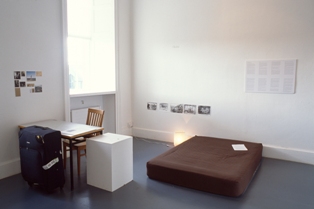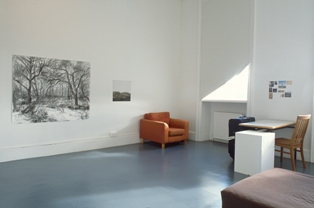Process Room, 12.10.06- 29.10.06
“The work in the process room is of an experimental nature. The author Lafcadio Hearn and I, working in different centuries, have both sought what nature means between pre-modern time 19c and modern time 21c through our practices. History, reality, delusion and marginality are common themes. Below is some background information on Lafcadio Hearn”
Patrick Lafcadio Hearn (June 27, 1850 – September 26, 1904), also known as Koizumi Yakumo after gaining Japanese citizenship, was an author, best known for his books about Japan. He is especially well known for his collections of Japanese legends and ghost stories, such as Kwaidan: Stories and Studies of Strange Things.
Hearn was born in Lefkada (the origin of his middle name), one of the Greek Ionian Islands. He was the son of Surgeon-major Charles Hearn, of Kings County (or County Offaly as it is now known), Ireland, and a Greek woman, Rosa Antonia Kassimati. Lafcadio Hearn moved to Dublin at the age of 6. It has been noted that artistic and rather bohemian tastes were in Lafcadio Hearns blood. He was injured in a playground accident in his teens, and lost his vision in his left eye, hence the pose in the picture inserted. It was later in his life in Japan, however, that Hearn found his home and his greatest inspiration. Most Japanese identify Hearn with Matsue, a region in Japan, as it here that his image of Japan was moulded. Today, The Lafcadio Hearn Memorial Museum and Lafcadio Hearns Old Residence are still two of Matsues most popular tourist attractions. Hearn married Setsu Koizumi, the daughter of a local samurai family, and became a naturalized Japanese, taking the name Koizumi Yakumo. While Lafcadio Hearn is no longer well known in the West, and is even falling out of common knowledge in Japan, he still has a small, fairly devoted fan base, and his influence on Western knowledge of Japan (though most cannot put his name to it) cannot be denied.
“A starting point for thinking; a complete work may only have one answer and result, incomplete work leads us to many possibilities for realising imagination”. Idetsuki Hideaki is concerned with the distance between human beings and their surroundings. He searches for the invisible both within and around people. “If we can notice the invisible in our surroundings, body and spirit then we will have a boundless landscape in our minds”. He aims to reintroduce the notion of everyday existence, revealing this through the mundane and turning every undertaking into a new idea. His work reflects many aspects of Japanese life. Recent group exhibitions for Idetsuki Hideaki include Echigo-Tsumari Triennale (2006), Aomori Contemporary Art Centre (2003), Centre for Contemporary Art Warsaw (2002), Turin Biennale (2002), Akademie Schloss Solitude, Stuttgart (2000), and a solo exhibition “Takahara Museum”, Takahara Old Elementary Branch School (2006).
For a printable vesrion of this information please download the following document  Idetsuki Hideaki Process Room doc.
Idetsuki Hideaki Process Room doc.
Click here to return to Previous Participants
Click  here to browse ARP Projects
here to browse ARP Projects

